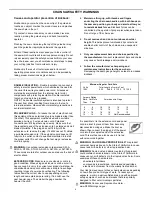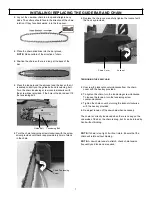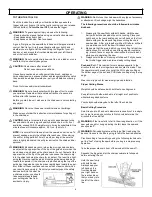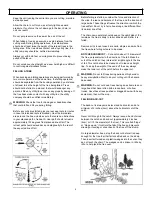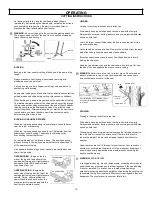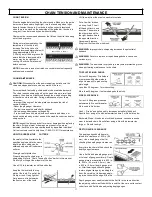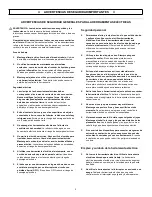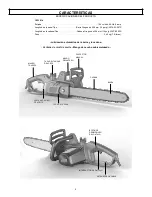
GENERAL POWER TOOL SAFETY WARNINGS
•
Disconnect the plug from the power source and/or the
battery pack from the power tool before making any
adjustments, changing accessories, or storing power
tools.
Such preventive safety measures reduce the risk of
starting the power tool accidentally.
•
Store idle power tools out of the reach of children and
do not allow persons unfamiliar with the power tool or
these instructions to operate the power tool.
Power
tools are dangerous in the hands of untrained users.
•
Maintain power tools. Check for misalignment or
binding of moving parts, breakage of parts and any
other condition that may affect the power tool’s
operation. If damaged, have the power tool repaired
before use.
Many accidents are caused by poorly
maintained power tools.
•
Keep cutting tools sharp and clean.
Properly
maintained cutting tools with sharp cutting edges are less
likely to bind and are easier to control.
•
Use the power tool, accessories and tool bits etc. in
accordance with these instructions, taking into
account the working conditions and the work to be
performed.
Use of the power tool for operations different
from those intended could result in a hazardous situation.
Service
•
Have your power tool serviced by a qualified repair
person using only identical replacement parts.
This
will ensure that the safety of the power tool is
maintained.
•
When servicing a power tool, use only identical
replacement parts. Follow instructions in the
Maintenance section of this manual.
Use of
unauthorized parts or failure to follow Maintenance
instructions may create a risk of shock or injury.
CHAIN SAW SAFETY WARNINGS
•
Keep all parts of the body away from the saw chain
when the chain saw is operating. Before you start the
chain saw, make sure the saw chain is not contacting
anything.
A moment of inattention while operating chain
saws may cause entanglement of your clothing or body
with the saw chain.
•
Always hold the chain saw with your right hand on the
rear handle and your left hand on the front handle.
Holding the chain saw with a reversed hand configuration
increases the risk of personal injury and should never be
done.
•
Hold the power tool by insulated gripping surfaces
only, because the saw chain may contact hidden
wiring or its own cord.
Saw chains contacting a live
wire
may make exposed metal parts of the power tool live
and
could give the operator an electric shock.
•
Wear safety glasses and hearing protection. Further
protective equipment for head, hands, legs and feet is
recommended.
Adequate protective clothing will reduce
personal injury by flying debris or accidental contact with
the saw chain.
•
Do not operate a chain saw in a tree.
Operation of a
chain saw while up in a tree may result in personal injury.
•
Always keep proper footing and operate the chain saw
only when standing on fixed, secure and level surface.
Slippery or unstable surfaces such as ladders may cause a
loss of balance or control of the chain saw.
•
When cutting a limb that is under tension be alert for
spring back.
When the tension in the wood fibers is
released the spring loaded limb may strike the operator
and/or throw the chain saw out of control.
•
Use extreme caution when cutting brush and
saplings.
The slender material may catch the saw chain
and be whipped toward you or pull you off balance.
•
Carry the chain saw by the front handle with the chain
saw switched off and away from your body. When
transporting or storing the chain saw always fit the
guide bar cover.
Proper handling of the chain saw will
reduce the likelihood of accidental contact with the
moving saw chain.
•
Follow instructions for lubricating, chain tensioning
and changing accessories.
Improperly tensioned or
lubricated chain may either break or increase the chance
for kickback.
•
Keep handles dry, clean, and free from oil and grease.
Greasy, oily handles are slippery causing loss of control.
•
Cut wood only. Do not use chain saw for purposes
not intended. For example: do not use chain saw for
cutting plastic, masonry or non
-
wood building
materials.
Use of the chain saw for operations different
than intended could result in a hazardous situation.
3




